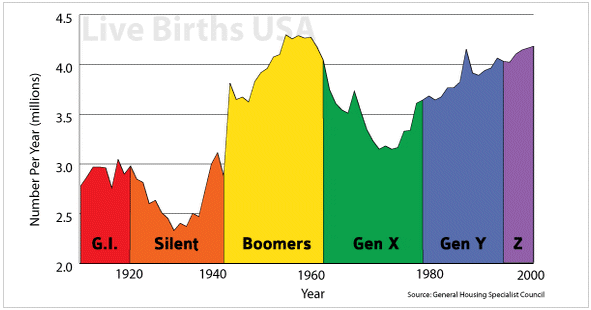It looks like the low-inventory era will be here for a while….
The statistics about the waves of baby boomers turning 65 each day are old news to anyone who works in a senior-focused industry.
But a new report from Harvard University adds a new twist to measuring the coming wave of American seniors: In 2035, households with members aged 65 and older will account for a full third of the homes in the country.
That’s one of the conclusions from a new report published by the Joint Center for Housing Studies (JCHS) at Harvard, which releases an annual look at the complexion of the U.S. housing market. And this year, the researchers specifically pointed out the ways elders will dominate the market for decades to come.
At present, 65-and-olders represent about one in four U.S. households, up from one in five just 10 years ago — thanks to a gain of 7 million senior households over that span. And in a little over 15 years, that number will grow to one in three.
“The aging of the U.S. population has also boosted the number of older households because the baby-boom generation is so much larger than the preceding generation,” the JCHS observed.
Homes headed by those 65 and older were also the only age group that had a higher rate of homeownership in 2017 than they did in 1987.
That growth is coming at the expense of the younger millennial generation, which despite reaching the age that their predecessors were when they began buying homes and starting families, still lags behind.
“In fact, household headship rates among young adults are still declining, albeit more slowly than after the recession,” the JCHS wrote in its report. “Indeed, 26% of adults aged 25-34 were living with parents or other relatives in 2017, while 9% were doubling up with non-family members — both shares all-time highs.”
In addition, adults of all ages are far less likely to move than in years past. While the greatest declines in household mobility have been concentrated among the young, the 65-and-older set has also become increasingly more entrenched in their existing properties.
“Many of the growing number of older households are staying in their homes longer than previous generations at their ages, rather than downsizing or moving to rentals,” the JCHS observed.
Demographic shifts also play a role: Even though the move rate for Americans aged 65 and older dropped by just a percentage point, the sheer volume of aging baby boomers means that change represents “significantly fewer residential moves.”
“There is no doubt that the number of older adults will reach an unprecedented high over the next two decades,” the Harvard team concluded. “With this growth will come different demands, challenges, and stresses on the housing stock.”
Link to Article




Moving is a pain and the older you get the more pain is involved.
I tell people, “Move while you can!”
It’s going to get much worse than that.
Telemedicine.
Self driving vehicles.
70 is the new 50.
Home delivery of everything else too. People aren’t going to be giving up theirs houses for reasons that used to force them to move.
Btw, I wore my “I’M NOT GIVING IT AWAY” t-shirt today.
I’ve been living with delivery for a couple of years due to injury. No auto insurance, no gas and no dealing with parking. If you like your house, why move?
Jim, maybe your next t-shirt could read
“I’M NOT LEAVING TIL THEY TAKE ME FEET FIRST”.
Is there a market for vintage JtR t-shirts?
https://www.ebay.com/sch/i.html?_nkw=jim%20the%20realtor&ssPageName=GSTL
The home, Zillow’s first foray into the iBuyer business, was purchased by the company for $410,000 on May 18 and initially listed for $425,000.
On June 14, the company lowered the asking price to $418,000.
“We’re getting good traffic,” Laughton told Inman. “I think we’re at the point now that it’s going to get an offer.”
Laughton said the decision to reduce was based on feedback he and Zillow have gotten on the home. He added that the market for homes is a little tougher over $400,000 in the Phoenix area, but in general it’s a hot market.
“The over $400,000 [homes] take a little bit more time than lower price points,” he said.
Price reductions can often drum up more interest, according to Laughton.
In an investor call last month, Zillow CEO Spencer Rascoff addressed that small profit margin. Even if Zillow were to, say, make $3,500 on average off of each home, with a large number of transaction it would turn a big profit.
“It’s too early to estimate how many sellers might choose to sell in this way or what our typical net profit per transaction might be, but, as an example, if 5 percent of sellers select this method, that is 275,000 transactions,” he said. “For illustrative purposes at scale, using $250,000 as the typical home value, a $3,500 net profit per transaction would result in a nearly $1 billion profit opportunity annually.”
“In addition, Instant Offers strengthens our Premier Agent business by delivering validated seller leads on the homes we don’t buy, paying Premier Agent commissions on the homes we do buy, generating potential mortgage revenue on the homes we sell, and creating an amazing experience for consumers who sell to us and buy from us,” he added.